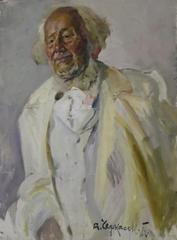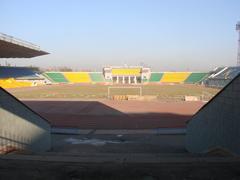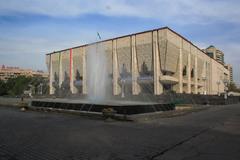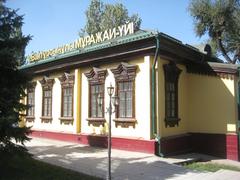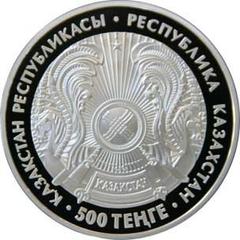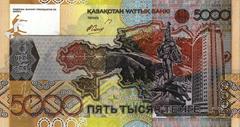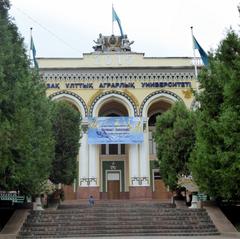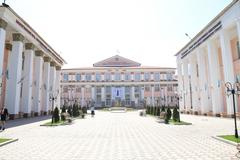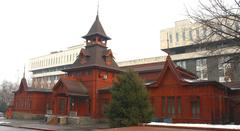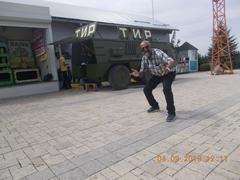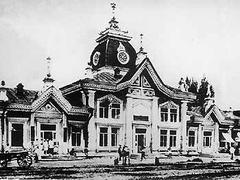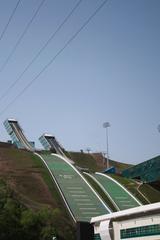
Doctor Fidler’s House Almaty: Visiting Hours, Tickets, and Historical Significance
Date: 04/07/2025
Introduction
Doctor Fidler’s House is one of Almaty’s most cherished historical treasures, offering visitors a rare glimpse into the city’s architectural heritage, urban development, and multicultural evolution. This iconic wooden residence, nestled within the Almaty Historical and Architectural Reserve, is emblematic of the city’s resilience in the face of natural disasters and political upheaval. Built in the late 19th or early 20th century for Dr. Fidler—a prominent physician who played a critical role in Almaty’s medical and social landscape—the house reflects a unique blend of Russian vernacular and local Kazakh influences. Today, it stands as a testament to Almaty’s layered identity and ongoing efforts to preserve its historical fabric amid modernization.
Whether you are an architecture enthusiast, history buff, or cultural explorer, Doctor Fidler’s House provides a meaningful window into Kazakhstan’s past. This guide offers comprehensive details on visiting hours, ticketing, accessibility, special events, and practical tips, ensuring you enjoy a rewarding visit. For deeper insights, reference resources such as Mexicohistorico.com, Tripzilla.in, and Welcome.kz.
Table of Contents
- Historical Context and Urban Evolution
- Architectural and Cultural Significance
- Visiting Information: Hours, Tickets, Accessibility
- Nearby Attractions
- Visitor Tips and Practical Advice
- Frequently Asked Questions (FAQ)
- Conclusion and Further Resources
Historical Context and Urban Evolution
Almaty, formerly Verny, evolved from a Silk Road trading post into Kazakhstan’s largest city, shaped by Russian imperial expansion, seismic events, and Soviet modernization. The 1887 and 1911 earthquakes devastated much of the city, sparking a wave of reconstruction that favored wooden architecture for its seismic resilience. Doctor Fidler’s House exemplifies this era, adopting traditional wooden techniques and decorative motifs that merged Russian and Kazakh styles (Wikipedia: Architecture of Almaty).
The home’s survival through political upheaval and urban redevelopment highlights the city’s complex relationship with its heritage. In the Soviet period, many wooden buildings were replaced by monumental concrete structures, but select sites like Doctor Fidler’s House were preserved for their historical value (Tripzilla.in). In the post-independence era, renewed efforts by local authorities and cultural organizations have ensured the continued protection and adaptive reuse of such landmarks (Mexicohistorico.com).
Architectural and Cultural Significance
Doctor Fidler’s House is a striking example of Almaty’s vernacular wooden architecture. Built with local Tien Shan spruce, the structure features an elevated stone foundation for earthquake protection, ornate wooden carvings, and a symmetrical, neoclassical-inspired facade (Welcome.kz). High ceilings, large rooms, and spacious verandas reflect both European influences and adaptation to the Central Asian climate.
The house is part of Almaty’s historical reserve, a district where Russian, Kazakh, and European architectural traditions coexist. Its association with Dr. Fidler illustrates the rise of Almaty’s professional class and the city’s embrace of modern medicine and education at the turn of the 20th century.
Ongoing preservation efforts have seen Doctor Fidler’s House used as a museum and cultural venue, hosting exhibitions, workshops, and educational events that foster community engagement and historical awareness (Adventure Backpack).
Visiting Information: Hours, Tickets, Accessibility
Visiting Hours
- Open: Tuesday to Sunday, 10:00 AM – 6:00 PM
- Closed: Mondays and major public holidays
Guided tours are available during open hours and can be booked in advance.
Tickets
- Adults: 500 KZT
- Students/Seniors: 300 KZT
- Children under 12: Free
Tickets can be purchased on-site or via the official tourism website. Discounts apply for groups and organized tours.
Accessibility
- Wheelchair Access: Ramps and adapted restrooms provided; some areas may have steps, so advance contact is recommended.
- Languages: Guided tours are offered in Kazakh, Russian, and English.
- Photography: Permitted without flash. Respect the preservation of artifacts by not touching or leaning on delicate woodwork.
Special Events
The house regularly hosts special exhibitions and cultural events, including workshops on seismic architecture, lectures on Almaty’s history, and local festivals. Check current schedules on the official website or with the Almaty Historical Reserve.
Nearby Attractions
Doctor Fidler’s House is centrally located and easily combined with other historical and cultural sites:
- Panfilov Park: Home to the renowned Ascension Cathedral (Zenkov Cathedral), a remarkable wooden church that survived the 1911 earthquake.
- Museum of Kazakh Folk Musical Instruments: Located within Panfilov Park, this museum features traditional instruments and live performances.
- Green Bazaar: A bustling market offering local specialties and souvenirs.
- Zhybek Zholy (Arbat) Street: A lively pedestrian area lined with shops, cafes, and street performers.
- Central State Museum of Kazakhstan: The largest museum in the country, showcasing Kazakhstan’s history and culture.
- Kok-Tobe Hill: Offers panoramic views of Almaty and the Tien Shan mountains, accessible via cable car.
- Big Almaty Lake: A scenic day trip for those seeking nature alongside culture (Advantour).
Visitor Tips and Practical Advice
- Getting There: The house is accessible by metro (Abay and Almaly stations), bus, or taxi (Yandex Go is widely used).
- Language: Russian and Kazakh are predominant; English is spoken in tourism sectors. Learning basic greetings is appreciated.
- Climate: Summers are warm (27–30°C); dress in light clothing and wear comfortable shoes.
- Currency: Kazakhstani Tenge (KZT); carry cash for small vendors.
- Health & Safety: Avoid tap water; use bottled water. Almaty is generally safe, but be mindful of pickpockets in crowded areas.
- Etiquette: Modest dress, polite greetings, and accepting offers of tea are signs of respect in Kazakh culture.
Frequently Asked Questions (FAQ)
Q: What are the opening hours of Doctor Fidler’s House?
A: Tuesday to Sunday, 10:00 AM to 6:00 PM. Closed on Mondays and public holidays.
Q: How do I purchase tickets?
A: Buy on-site or book in advance through the official tourism website.
Q: Is Doctor Fidler’s House accessible for visitors with disabilities?
A: Partial accessibility is provided; contact the venue ahead for assistance.
Q: Are guided tours available?
A: Yes, in Kazakh, Russian, and English. Tours enrich your understanding of the site.
Q: What attractions are nearby?
A: Panfilov Park, Ascension Cathedral, Museum of Kazakh Folk Musical Instruments, Green Bazaar, Zhybek Zholy Street, Central State Museum, Kok-Tobe Hill, and Big Almaty Lake.
Q: Can I visit independently or only via tours?
A: While independent visits are possible during opening hours, guided tours are recommended for a fuller experience.
Conclusion and Further Resources
Doctor Fidler’s House stands as a powerful symbol of Almaty’s resilience, multicultural heritage, and architectural ingenuity. Its preservation and active role in community life make it a must-visit for anyone interested in Kazakhstan’s urban story. Combine your visit with nearby attractions for a well-rounded experience of Almaty’s history and contemporary culture.
For the latest updates on visiting hours, ticketing, and special events—or to enrich your exploration with audio tours—download the Audiala app. Explore more through our related articles and follow us on social media for travel inspiration and cultural news.
Visuals and Media
Interactive Map of Doctor Fidler’s House and Nearby Attractions
Sources and Further Reading
- Mexicohistorico.com (2024)
- Tripzilla.in (2025)
- Welcome.kz: Almaty Historical Reserve
- Advantour. Learn more about Almaty’s history
- Orangesmile.com (2024)
- Adventure Backpack: Almaty Culture
- Audiala. Almaty travel guide

